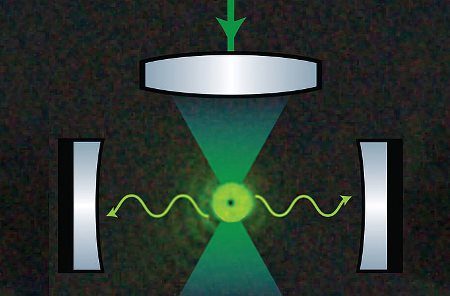Quantum cooling, an intriguing process at the intersection of fundamental physics and cutting-edge engineering, embodies the manipulation of light to achieve remarkably low temperatures in materials at the nanoscale. This phenomenon emerges from the principles of quantum mechanics, which govern the behavior of particles at atomic and subatomic levels. This article seeks to elucidate the nuances of quantum cooling, exploring its methodologies, implications, and potential applications across various scientific domains.
At its core, quantum cooling involves the utilization of photons—the elementary particles of light—to induce a cooling effect in particles that possess thermal energy. Phenomena such as Doppler cooling and resolved sideband cooling exemplify the diverse approaches to achieving this end, each characterized by its unique operational principles. Both techniques capitalize on the interaction of light with matter but differ in terms of their applications and efficacy.
The process of Doppler cooling represents one of the earliest and most straightforward advancements in quantum cooling techniques. By directing laser beams at particles moving at a certain velocity, it is possible to exploit the Doppler effect—wherein the frequency of light experienced by the moving particle shifts due to its motion. As photons collide with the particle, they impart momentum that, counterintuitively, serves to slow down the particle’s velocity. This reduction in speed results in a decrease of the particle’s thermal energy, hence leading to an effective cooling of the material.
On the other hand, resolved sideband cooling represents a more sophisticated approach suitable for systems in which greater precision is required. In this technique, lasers target vibrational modes of trapped ions or atoms. As such vibrational states are quantized, energy can be selectively extracted from a specific mode, reducing its vibration amplitude and thus its thermal energy. Furthermore, this method is adept at achieving temperatures close to absolute zero, which has profound implications for quantum computing and quantum information science, where maintaining low thermal noise is critical.
The significance of quantum cooling transcends mere temperature reduction; it also opens avenues for exploring fundamental aspects of quantum mechanics. The cooling of particles to ultra-low temperatures leads to phenomena such as Bose-Einstein condensation, a state of matter in which a group of bosons occupies the same quantum state, thereby exhibiting quantum behaviors on a macroscopic scale. This transition provides insights into quantum phase transitions, enhancing our understanding of the interplay between temperature and quantum coherence.
Furthermore, quantum cooling serves as a precursor to the development and stability of ultra-cold systems, crucial for experimental advancements in quantum technologies. With enhanced control over thermal states, researchers can manipulate and entangle quantum states with unprecedented precision, propelling forward the realms of quantum computing and secure communications. This capability inherently leads to the design of qubits that can operate with minimal decoherence, a significant hurdle in quantum processor efficiency.
The application of quantum cooling techniques is manifold and is beginning to permeate various fields beyond fundamental research. For instance, in the domain of precision measurement, cooled atoms provide an exquisite basis for highly sensitive atomic clocks and enhanced gravitational wave detectors. By minimizing thermal fluctuations, these systems achieve new levels of sensitivity, enabling breakthroughs in metrology and astrophysics.
Moreover, quantum cooling holds relevance in the burgeoning field of optomechanics, where the interaction between light and mechanical oscillators can reveal insights into both quantum phenomena and classical mechanics. The manipulation of mechanical modes through cooling not only aids in studying quantum behaviors but also shows promise in developing technologies such as quantum sensors and communication devices that interlace classical and quantum realms.
The research landscape surrounding quantum cooling is dynamic, with ongoing advancements leading to innovative experimental techniques. For example, advances in optical lattices have allowed for more refined control over atomic ensembles, facilitating the exploration of complex quantum phases and interactions not previously accessible. This ability to cool and manipulate atomic gases with light fosters a fertile ground for investigating novel quantum materials and phenomena.
As we move forward, the practical implementations of quantum cooling technologies are expected to proliferate. One can envision a future where nano-scale cooling techniques contribute to the efficiency of electronic devices dramatically. Integrating quantum cooling with existing semiconductor technologies could enhance the performance and reduce energy consumption of devices, thus aligning with the global inclination toward sustainable technology practices.
In summary, quantum cooling emerges as a transformative frontier in the intersection of quantum mechanics and practical applications. With techniques such as Doppler cooling and resolved sideband cooling paving the way for unprecedented modifications of particle states, the realm of possibilities expands dramatically. The foundational understanding gained from leveraging light to manipulate particle behavior not only offers insights into quantum mechanics but also positions itself as a catalyst for groundbreaking technologies that stand to redefine multiple facets of modern science and engineering. It is a striking testament to the ingenuity in harnessing the subtleties of light, a quest that continues to unfold in remarkable ways.












